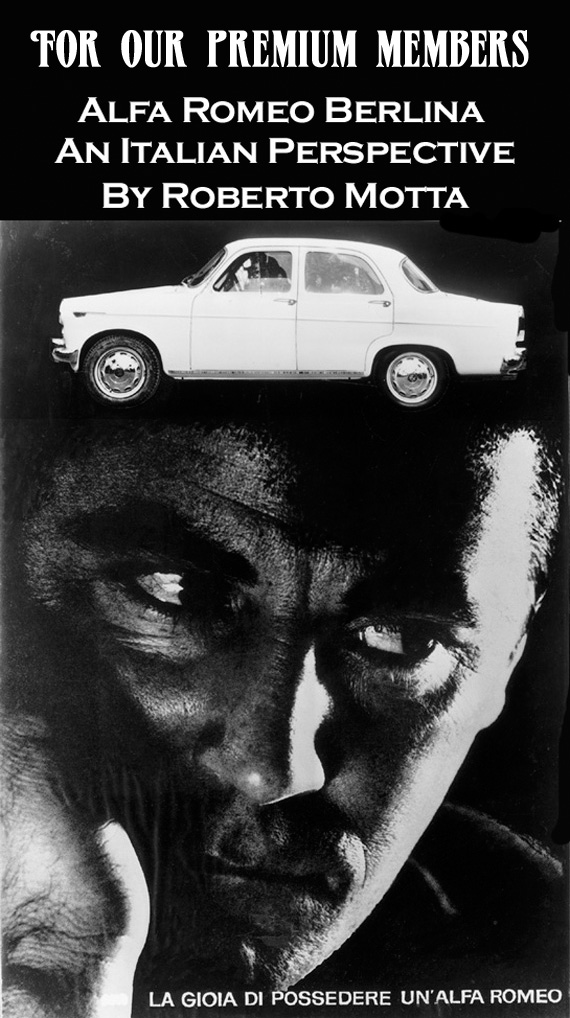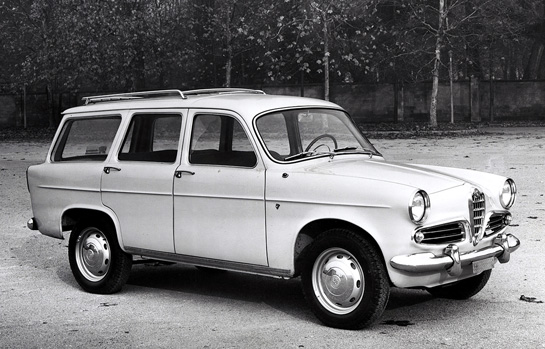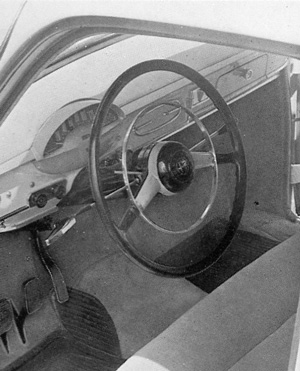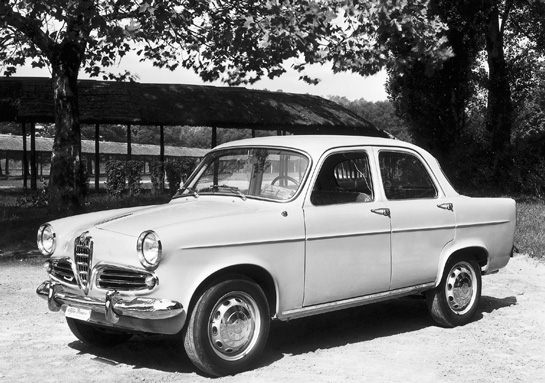All Black and White images © Alfa Romeo Automobilismo Storico, Centro Documentazione (Arese, Milano)
This is the third in our series of articles about the 1955-1961 Alfa Giulietta Berlina.
For Italy, the post war era was full of significant changes that would last more than a decade; these were the years of the Cold War as opposed to the dream of a united Europe; the launching of the first atomic-powered submarine; the Warsaw Pact; the birth of Rock ‘n’ Roll; Sputnik from the east and Barbie dolls from the west; the success of the Beatles and the death of Kennedy that signaled the end of an era.
With all due respect for the beauty of Rita Hayworth, the lines of the Alfa Romeo Giulietta had something more: it was a car with a dual personality. Compact, aggressive and peaceful at the same time, the new family sedan was the ideal vehicle to transport children to school, while at the same time engage in competition on the weekends on track all over the world.
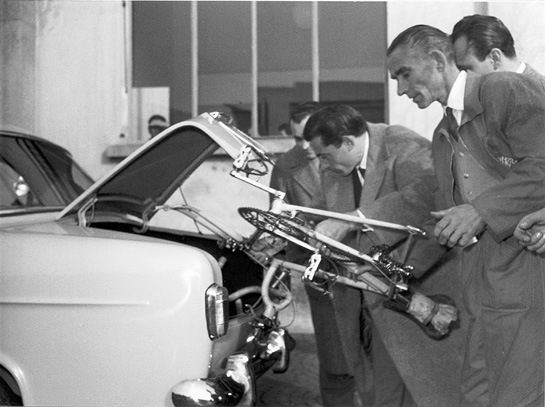
Italian bike champion Fausto Coppi fits his bike into the trunk of the new Berlina. Coppi won the Giro d Italia.
Its design phase was initiated in late 1951 with the project named ‘Type 750’. The name served to deceive the competition, pretending that Alfa was interested in making a car with engine capacity below one thousand cubic centimeters.
This unique project was a collaboration of a group of exceptional technical engineers: Orazio Satta Puliga (1910-1974), project manager; Giuseppe Busso (1913-2006), head of research for the engines; Ivo Colucci (1914-? for the body; Giampaolo Garcea (1912-1987) responsible for the testing and development, and Rodolfo Hruska (1915-1995), formerly the right hand of Ferdinand Porsche.
However, we can say that the real father of the Giulietta was the project engineer Satta, the man who also created the magic formula of “Alfa Romeo sports for all” (“Alfa Romeo sportiva per tutti”) and was the first to realize the importance of limiting the weight of the car.
Satta’s goal explains the extensive use of aluminum alloys, starting from the alloy engine which used steel liners, the entire differential case, and the exquisite finned brakes. Moreover, in the aim to keep the weight, the body was, like the 1900, a monocoque-unitized body designed to carry all the loads, eliminating a heavy separate chassis.
Today all of this seems commonplace, but in 1955, the refinements embraced by the new Giulietta–the powerful and flexible DOHC 1300 cc four-cylinder engine, the sturdy suspension, the well located rear axle differential, coil spring suspension and powerful and effective brakes—were very advanced. For example, at the time, only Jaguar offered a DOHC engine on a production car but the Alfas would be offered for far less money.
As the project continued, the poet Leonardo Sinisgalli (1908-1981) proposed the name Giulietta, which resounded with the name Alfa Romeo. The urgency dictated by the heavy economic investment and the need to show results led the company to create a small sports coupe which could be produced much more quickly than the Giulietta sedan, which required a great deal of new tooling. The sports coupe, called the “Sprint”, therefore was the first model to be launched on the market and this job was carried out directly in the factories of Nuccio Bertone.
Shown first in September of 1954, the Sprint was an immediate success, exceeding all expectations. The following year came the 1300 Berlina, which became the version preferred by the public. With this latest version, the Alfa Romeo became the favorite of fathers and families. If they couldn’t afford a Berlina, they could and did follow the racing debut in September of that year when, driven by Sergio Mantovani, the new Berlina took part in the Trofeo Automotive Supercortemaggiore.
Two years later, in September of 1957, the Berlina was accompanied by the TI (Turismo Internazionale), which boosted the power to 65 hp at 6150 rpm, thanks to a raised compression ratio of 8:1 and the use of a Solex 32 APAIG downdraft. The TI easily reached 90 mph (150 km / h). 1958 models also featured an improved Porsche synchromesh four speed transmission. The glorious Giulietta TI became the car that lifted the fortunes of Alfa Romeo.
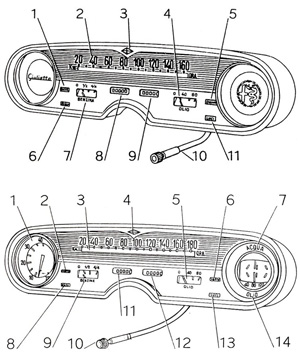
In 1959 the dash became linear. Top is the Berlina Normale, below the TI version with a round tach at left.
The TI differed from the normal Berlina, having better instrumentation, larger rear lights and the appearance of tails protruding from the fender. It supplanted the normal Berlina line, and contributed significantly to increasing the sporting image of Alfa Romeo. It soon gained a great popularity because of its dual purpose nature, being used in speed trials, rallies, racing, and yet in the streets everyday life. We can say without a shadow of doubt that for Italians, the TI was the most beloved Giulietta.
One of the things that enabled the success of this car was certainly the ease with which it could be driven. It could be driven for miles without a great deal of fatigue. In addition to driving the car to the event, many race drivers also used it for daily travel.
Over the years, the best racing results were posted by tuners Bosato, Conrero and Facetti, in whose hands the TI was able to deliver over 100 hp at engine speeds above 7000 rpm, and achieve over 190 kph (118 mph). The handling was improved by simply replacing the shock absorbers and tires, a choice that provided a balance of oversteer with a controllable rear end.
TI made its rally debut of the Monte Carlo Rally in 1958 and it was an exceptional event: the crew of Anzil and Spjuth took the victory in the Tourism category, while Gacon/Borsa was victorious in the Tourism “special” category and took second place overall. There, Alfa Romeo’s win also earned them the Challenge de l’Equipe, awarded to the manufacturer with the best overall results.
The success of Monte Carlo were followed by other important results, including a class win at the Tour de France, which it then won for five straight years, from ’58 to ’62. From 1956 to 1964, the Berlina and TI achieved no less than 92 class and overall victories in rallies alone!
In ’59, the Giulietta Berlina was modified primarily for aesthetic reasons, with the adoption of a new grille, a new rear lights and a new horizontal instrument panel. In terms of racing, there was the victory in the Italian Touring Car Championship with Gianfranco Bonetto. In 1960, Anzio Zucchi took the TI to victory in the Mountain and Trophy in 1964, Enrico Pinto won the Italian Touring Car Championship.
In 1961 the latest version of the famous sedan featured yet another grille and the front bench was replaced by two separate and reclining seats.
Further developments to the engine meant 74 hp at 6300 rpm and pushed the car to over 165 km / hour (102 mph). At the end of 1962, on request, one could finally get a TI with a floor shift.
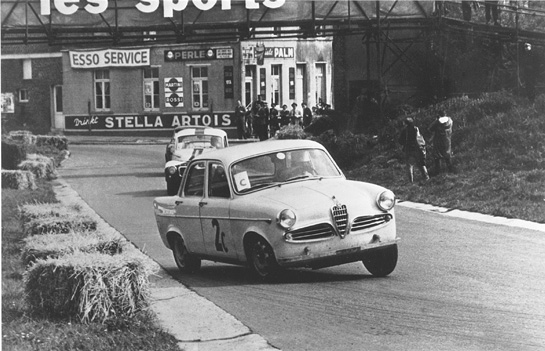
A TI leads a Volvo at a race in Italy circa 1961. The car gained over 230 class and overall victories in Italy between 1956 and 1966.
In ’64, the legendary TI went out of production
During its career it has won countless number of victories among which was the Giro di Sicilia (’58), the Mille Miglia (’58, ’59 and ’61), the 9 hours of Johannesburg (’58, ‘ 60 and ’62), the 12 hours of Hockenehim (’61), the 12 hours of Nürburgring (’62), the Rally of Monte Carlo (’58 and ’60), the Acropolis Rally (’58 and ’59) The Tour de Corse (’58 and ’59) and the Coupe des Alpes (’58 and ’61). Tito Anselmo listed over 230 class victories for the Berlina between 1956 and 1966.
Then, the advent of Giulia and tougher competition from Abarth on the tracks and the Mini Coopers in rallys, meant the old Berlina had finally seen its day.
But the TI has never left the scene: its qualities of strength and longevity and, above all, its magical power to create emotion made it irreplaceable in the hearts of fans. The Giulietta TI was produced in 92,658 copies, a number that is equivalent to over half of the Giulietta, with a total of 180,000 units were produced.
Of course Alfa also produced a wide range of models to suit the need of any ‘Alfista’: Sprint (1954), the Berlna (1955), the Spider (1955) , the Sprint Veloce (1956), Sprint Speciale and the TI Sedan (1957), the Sprint Zagato (1960). In addition, between ’57 and ’59, the Giulietta was available as the Giardinetta Hills Promiscuous or, as we would say today, station wagon version. Only 91 of the station wagons were produced, and most of which were used as police vehicles.
Like every Alfa Romeo, the Giulietta Berlina was something that went far beyond the simple definition of ‘automobile’: it was one of those symbols that represent a specific way of life and the idea of freedom and speed of movement. Like most great cars, it was a car with character with the ability to go straight to the the heart, and turn any car lover into an ‘Alfista’.
References:
Alfa Romeo Giulietta, Tito Anselmi, Nada, 1998
Other articles in the Alfa Berlina Series
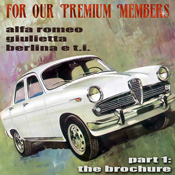 Alfa’s Giulietta Berlina
Alfa’s Giulietta Berlina
The Alfa Giulietta Berlina should have been the greatest sedan of the 1950s. We kick off a multi-part look at the semisweet success of Alfa’s first Giulietta, the Berlina, with a fascinating original brochure reproduced at 300 dpi. This is followed by a owners’ manual already available. Coming soon, the full history of the 1300 Berlina, variants, competition history and much more.
 Alfa Giulietta Berlina Manual
Alfa Giulietta Berlina Manual
Part of an in-depth series of Premium articles about the much-neglected Alfa Giulietta Berlina, this segment offers a rare look at a Alfa 1300 Berlina owner’s manual. The series also includes factory brochures, a full history, variants, and much more, all dedicated to what should have been the most advanced sporting saloon of the 1950s.
Available to Premium members now.
